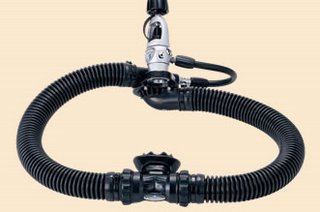Friday, March 31, 2006
Twin Hose Regualtors Trying to Make a Comeback

A little over a year ago, Aqua Lung America (aka U.S. Divers, I am not sure when they changed their name) released a “modern” version of the classic double hose regulator. Designated “Mistral” in honor of its ubiquitous single-stage, double hose regulator of the 1950s, the new regulator is a two-stage design, joined in a single unit, behind the divers head, which is where the bubbles exhaust.
One UK website noted “older divers will look back with nostalgia at the days of the original twin-hose regulator. But it had a single-stage mechanism and breathed like an asthmatic ant.” Scuba Diving magazine in an equipment review article predicted “the Mistral's unique double hose design will appeal to underwater photographers, videographers, ice divers, commercial divers, military divers, search and rescue divers, scientific divers, and anybody nostalgic for the 'good ol' diving days." Don Rockwell, president of Aqua Lung America, echoing these sentiments, notes on the company’s website "divers miss the many benefits of the double house regulators – plus, they're nostalgic for scuba equipment from the early days. So we combined the best features of the old double hose regulator – including having the bubbles come out from behind the diver's head and not obstructing the field of vision – and updated it with new modern regulator technology."
Now, I have been diving single hose regulators for a while and have never found bubbles to be particularly obstructing or bothersome. I am an older diver, who has been an underwater photographer (albeit not a very good one), videographer (ditto), search and rescue diver, and a scientific diver. I did not clamor for the return of the double-hose regulator; neither did my colleagues. Nor do I particularly long for the “good old days” that for me began more than two decades ago with the acquisition of my first regulator, a U.S. Divers Conshelf 14. At that time, many dealers already considered this reg to be “old” technology. Newer, easier breathing, and more lightweight plastic second stage regulators were rapidly relegating the heavy marine brass regulators to the bottom shelf of the glass display cases in dive shops. Nowadays, the 14 and regulators like it are more likely to appear on a dive shop’s “wall of honor” along with other “classic” regulators. I might still be using the regulator but it lacks sufficient low pressure ports to accommodate the second stage, a B.C. inflator hose, and a drysuit inflator hose—all of which I consider a necessity more than a nice to have feature. I have purchased two regulators since then, a Conshelf 21 and an Apex ATX 40. I still have and use both.
Now I will admit, I like the looks of the modern Mistral. It seductively screams “Sea Hunt,” unique,” and “novel.” When the regulator was introduced, I mentioned to a 20-something gear head with whom I Yahoo IM’d about scuba that I thought I might get one, but that the $900 suggested retail price was a real turn off. He noted that I seemed “old school.” It must have been my attitude that gave it away; I know he couldn’t see the black Converse “Chuck Taylor” high-top sneakers that I wear. I also knew that many divers felt the same way but unlike me had never dived with a double-hose regulator and did not know what a pain in the ass they could be. Sure enough, they soon started appearing on EBAY auctions and at gear sales going for as little as one-half of the original price. So I waited, watched and a couple of weeks ago I scored one. My initial experience diving with it at a local pool will be the subject of a future blog.